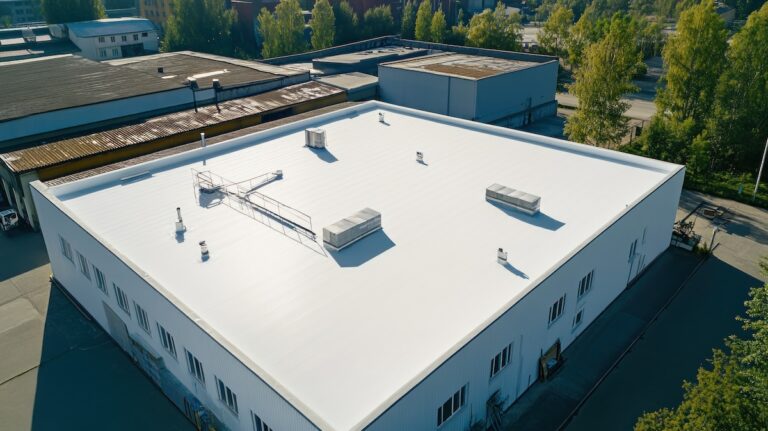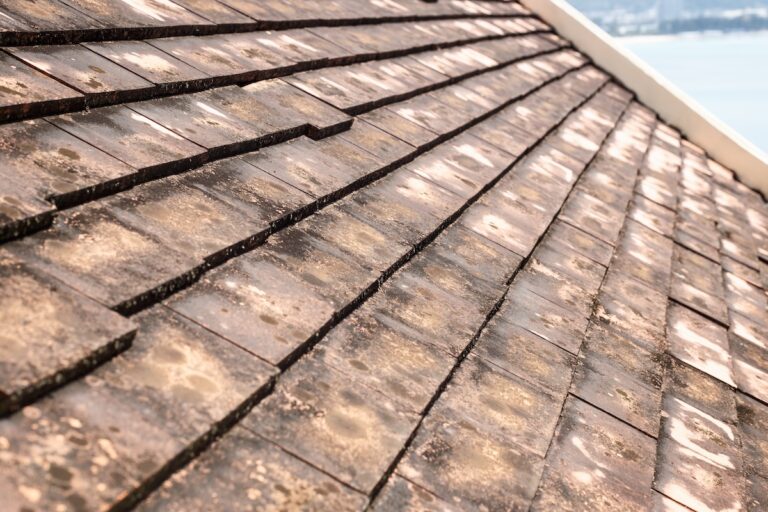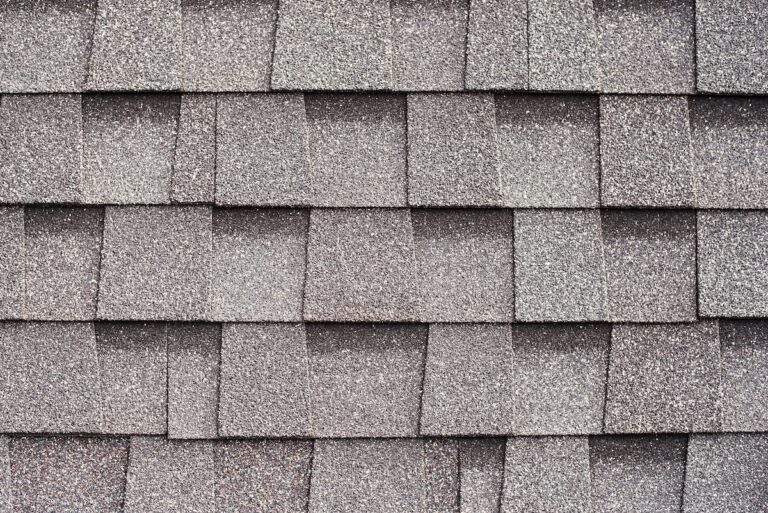Cutting metal roof panels may seem intimidating, but with the right tools and techniques, it’s a manageable DIY task or one you can confidently oversee when hiring a contractor. Whether you’re customizing panels for a tricky roofline or simply trimming edges to fit, knowing how to do it correctly ensures clean results and avoids damaging your materials.
- Safety: Working with metal involves sharp edges and loud tools—protective gear is essential.
- Tool selection: Not all cutting tools are created equal; the right choice depends on your precision needs and panel type.
- Finish quality: Proper cuts help avoid jagged edges that lead to rust or poor fit during installation.
In this blog, we’ll walk you through the process step-by-step so you can cut metal panels accurately and safely.
✅ Why Cutting Stand Seam Metal Panels Correctly Matters
- Precision Affects Fit and Appearance: Metal roofing is not forgiving when it comes to errors. Even a slightly off cut can result in gaps, poor alignment, or an uneven finish. Precision ensures your roof looks great and performs as intended.
- Improper Cuts Lead to Damage: Using the wrong tools or poor technique can create burrs, warp the panel edges, or strip protective coatings—leading to faster corrosion and future repairs.
- Safety Risks Are Real: Cutting through steel or aluminum without the right safety gear or process can lead to injuries from sharp edges or flying metal fragments.
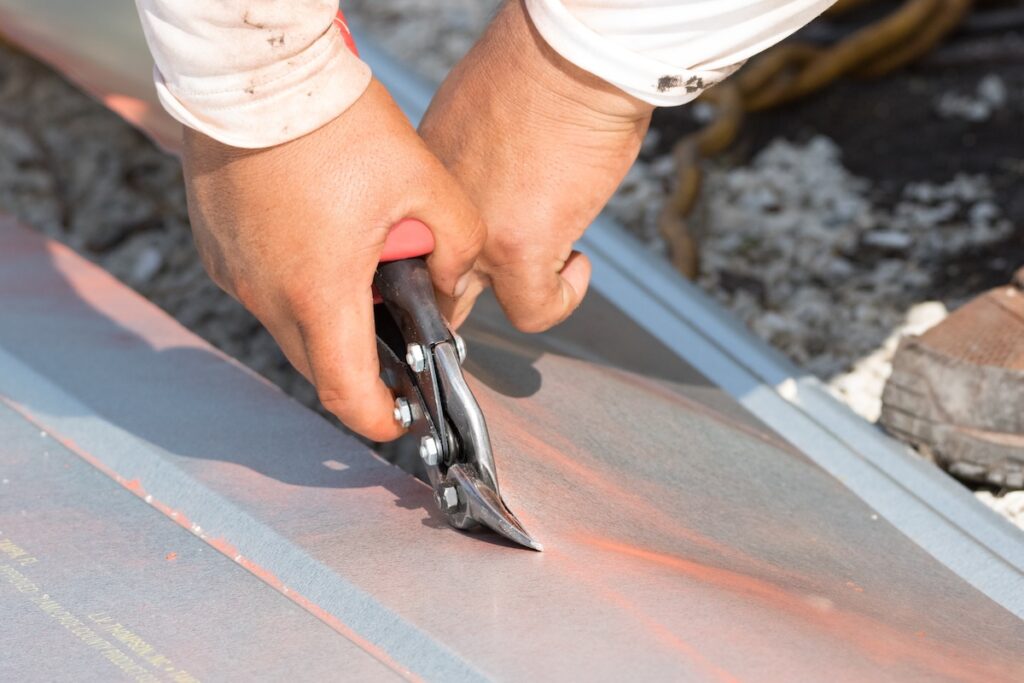
🛠️ Best Tools for Cutting Metal Roof Panels
Electric Metal Shears
Electric shears are fast, efficient, and ideal for straight cuts. They’re easy to control and reduce the risk of damaging the panel’s coating. As roofing experts, we recommend this option for business owners undertaking larger projects, since it’s a smart investment or rental option.
Nibblers
Nibblers punch through metal cleanly and are great for irregular shapes or intricate trim work. They create small waste pieces (chads), so sweep up thoroughly to prevent rust or debris buildup.
Tin Snips
Tin snips are affordable and perfect for smaller cuts or touch-ups. Be sure to use the right directional pair—left, right, or straight—depending on the cut path. They’re especially handy when working in tight corners or doing on-site trimming.
Circular Saw with Metal Blade
A circular saw provides long, straight cuts quickly. Use a fine-tooth blade made for metal and go slowly to reduce heat and prevent burning the protective finish. Always support the full length of the panel to prevent bending.
Angle Grinder
An angle grinder can be effective for cutting vents or shaping corners. Due to the heat it generates, it’s not recommended for coated panels unless followed by proper edge treatment to prevent rust.
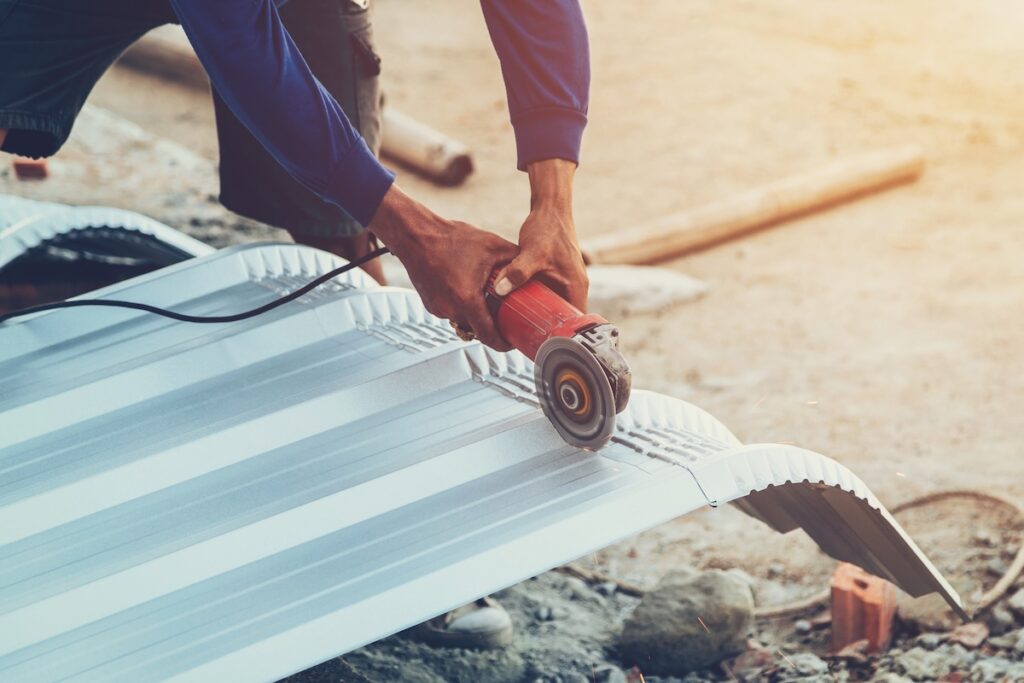
📋 7 Step Guide: How To Cut Metal Roof Panels
1. Measure Your Cut Lines Accurately
Use a tape measure, marker, and chalk line to mark your cuts. Double-check dimensions and always allow for any overlap if you’re planning panel seams.
2. Set Up a Safe Work Area
Find a flat, stable surface like a sawhorse setup or clean garage floor. Lay panels on a soft mat or blanket to avoid scratching. Ensure there’s proper ventilation if you’re using power tools.
3. Choose the Right Tool for the Job
Match your tool to your job:
- Straight lines: Electric shears or circular saw
- Curved cuts: Nibblers
- Small trims: Tin snips
- Vent openings: Angle grinder
4. Put on Protective Gear
Wear heavy-duty gloves, long sleeves, safety glasses, and hearing protection. Consider a dust mask if working indoors or with steel shavings.
5. Make the Cut Slowly and Steadily
Keep firm control of your tool and follow your guide marks closely. Let the blade or shears do the work without forcing them. For saws, cut from the underside to preserve the visible finish.
6. Check the Cut Edge for Burrs
Run your fingers (carefully, with gloves) along the edge to feel for sharp bits. Smooth with a metal file to avoid injuries or premature rusting.
7. Clean Up and Store Panels Properly
Brush off metal shavings and debris to keep your workspace tidy. Stack panels in a dry place, preferably indoors, to avoid moisture damage before installation.

⭐️ Tips for Easier and Cleaner Cuts
- Panel stability: Clamps help reduce movement and vibration, especially when using power tools.
- Score first: For extra precision, lightly score the line before making the full cut.
- Mind your coating: When working with pre-painted panels, take care not to scratch or remove the finish.
- Keep extras on hand: Have a few extra panels available in case of mistakes or miscuts.
- Work in daylight: Natural light makes it easier to spot your lines and catch mistakes early.
❌ Common Mistakes To Avoid
Rushing the Job
Trying to cut too quickly leads to jagged edges, tool slips, and costly material waste. Slower cuts tend to be cleaner and more accurate.
Using the Wrong Blade or Tool
A wooden blade or old saw can warp your panel or leave burn marks. Always check that the blade is sharp and rated for metal roofing.
Skipping Protective Equipment
Even quick jobs can result in dangerous cuts or eye injuries. Don’t take shortcuts on safety gear.
Cutting Without Support
Unsupported panels may flex or shift, making your cuts uneven. This also increases the risk of damaging surrounding panels or your tools.
📞 When Should You Call a Professional Instead?
Cutting metal roofing isn’t always a one-size-fits-all project. If you’re facing one of the following challenges, hiring a pro roofing company in Pennsylvania like G. Cannon can save you time, stress, and costly mistakes:
- Steep roof pitches: Working at a steep angle increases risk of injury and makes precise cutting more difficult.
- Architectural details: Valleys, hips, and skylights require angled cuts that are difficult for beginners.
- Large-scale installations: If you’re installing a full metal roof, speed and consistency are essential—areas where professional crews excel.
- Structural uncertainty: If you’re not sure how your panels should fit your roof’s shape or slope, a contractor will ensure correct alignment and spacing.
- Limited tools: If you don’t have the proper cutting tools or safety gear, the cost of renting may outweigh the cost of hiring help.
💪 Cut With Confidence—Or Let G. Cannon Handle It
Cutting metal roof panels is a skill that gets easier with the right tools, technique, and planning. From measuring to smoothing the edges, each step plays a role in creating a watertight, visually appealing roof. While DIYers can definitely take on small projects with care, more complex rooflines or full roof installs are best left to experienced roofers.
At G. Cannon, we bring precision, safety, and craftsmanship to every roofing project. Whether you need one tricky cut or a full metal roof installation, we’re here to help. Reach out today for a free estimate and let us deliver roofing solutions that last.

